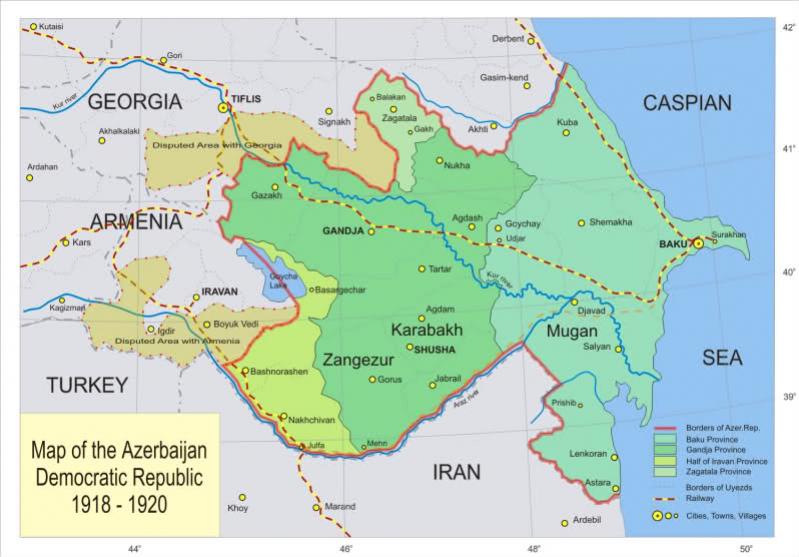


Releasing from the thraldom of the Russian Empire, which lasted for approximately 120 years, the Azerbaijani people established a new independent state in the Northern Azerbaijan. The Declaration of Independence of the Azerbaijan Democratic Republic stated that the lands of Northern Azerbaijan, once occupied by Russia in accordance with the Gulistan (1813) and Turkmenchay (1828) agreements are the legal heritage of Azerbaijani people. The first article of the declaration read: "Beginning from this day the people of Azerbaijan will have their sovereign rights. Azerbaijan, that consists of Eastern and Southern Transcaucasia, is a legal independent state".
The Azerbaijan Democratic Republic issued its politically and legally substantiated map. It tried to spread its power on the entire historical area of Karabakh. At that time the newly established Republic of Armenia laid its groundless claims to Karabakh, but the government of the Azerbaijan Democratic Republic opposed these claims. During the talks with the Foreign Minister of the Ottoman state in Istanbul, November 18th 1918, A.M.Topchubashov (1862-1934), the chair of the Parliament of the Azerbaijan Democratic Republic said: "The Karabakh issue raised by Armenians does not concern only 5 or 10 villages, it covers all four districts: Shusha, Djavanshir, Djebrail and Zangezur. This territory belongs to only one nation and even though the number of Moslems and Armenians is not equal, there is no reason to talk in terms of domination of Armenians, because they are not native residents of these areas. These are those moving to the region from Turkey after the war with Russia…Finally, Armenians do not live separately in Karabakh itself, they form mixed settlements with Azerbaijanis. Nevertheless, we stand for the peaceful settlement of the problem".
Armenians continued previously committed acts of genocide for the occupation of Karabakh in the period of the Azerbaijan Democratic Republic as well. Taking into account the established situation, the government of Azerbaijan created a Karabakh governorship-general dealing with the accidents in Shusha, Djavanshir, Djebrail and Zangezur in January, 1919 and appointed Kh.Sultanov the governor-general of Karabakh. The Foreign Minister of Armenia expressed his discontent with the establishment of the governorship-general, yet the response of Azerbaijani government considered the protest to be baseless and stated that these areas are the integral part of the Azerbaijan Republic. Karabakh governorship-general had to carry out its activity in conditions of the struggle against Armenia's claims and the tense relations first with Englishmen and then with Americans. However, Armenians did not give a chance to establish peace in the region of Karabakh governorship-general.
In late 1919-the spring of 1920 the armed brigands of Armenian dashnaks attacked the civil inhabitants of Zangezur and committed mass bloodshed.
Armenians were also active in Djavanshir district. Their attacks to the foothill villages of Djavanshir became habitual. In spring-summer of 1918 Armenian brigands committed numerous acts of violence against the Muslim residents of the flat regions of Djavanshir. "Armenians, changed the direction of the Tartar river thus cutting off the water supply to the Aran village inhabitants and causing a great damage to them. The situation deteriorated to the level when villagers did not have enough fresh water to drink".
Another district of Karabakh-Djebrail was also subject to Armenians' armed attacks. They intensified their attacks on Djabrail in December of 1918, while in early 1919 the aggression acquired more destructive nature.
The barbarism of Armenians acquired a more violent form in Shusha, the political center of Shusha province and Karabakh.
In period of the Azerbaijan Democratic republic the meanest armed revolt of Armenians tool place during the traditional festivity of Azeri people Novruz in Shusha on March 22, 1920. This separatist revolt was proposed by Bolsheviks, preparing to occupy Azerbaijan. Despite the suppression of separatist revolts in a number of regions they managed to invade the tower of Askeran. As a result of military-political measures Azerbaijan Democratic Republic restored the sovereign rights of Karabakh. However, the separatist revolts and genocides committed by Armenians, betraying the country they resided in, on the eve of April, 1920's occupation, stroke a hard blow to the defense of northern borders of the country and intensified the overthrow of the independent Azeri state-the Azerbaijan Independent Republic.
Source: Yagub Mahmudov, Karim Shukurov Garabagh - Real history, facts, documents, Baku – 2005